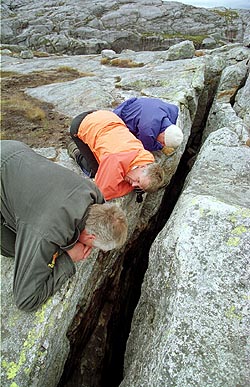![]() n Norways west coast lies a beautiful, long fjord called
Lysefjord. It is surrounded by spectacular cliffs, some of them up to more than
1000m high. The highest, Kjerag, is much used by base jumpers and is visited by
many people every year for its spectacular views.
n Norways west coast lies a beautiful, long fjord called
Lysefjord. It is surrounded by spectacular cliffs, some of them up to more than
1000m high. The highest, Kjerag, is much used by base jumpers and is visited by
many people every year for its spectacular views.
The path to Kjerag takes one across some pretty desolate landscape, scoured clear of vegetation by the prevailing western wind. The actual cliff face of Kjerag is slowly separating from the land mass behind it, and there are several deep cracks. One of the is more than 200m deep, but no more than half a meter wide.

It was into this crack that a small cocker-spaniel named Pluto fell in october 2000. She tried to jump the crack (which hikers on the path cross almost without noticing it), and for some reason failed. Her owner turned round at the sound of desperate scrabbling, just in time to see Pluto disappear.
A furious barking showed that Pluto had survived the initial fall, but how to get her up? The crack is so narrow that it's hardly possible to squeeze into it. The local alpine rescue group (which is extremely competent) declared the task impossible - and anyway, a (presumably) wounded dog was expected to die soon, anyway.
Pluto's owners went home, stricken with grief. And Pluto lived on. After several days, hikers heard her bark. Various means were discussed for getting her out, or getting food (or a camera) down to her, but the narrowness of the crack precluded all attempts. An article in the local newspaper expressed curent opinion, that Pluto would die soon and noone would ever know the details.
After another few days, Pluto was heard again. This time she made national radio, and my friend Lars Tore, sitting in his huge 60-ton shovel loader in a stone quarry, heard it. Ten seconds later the phone beside my PC rang - "This one is ours! I know the crack and we can just make it!". This started a process of much telephoning, and to make a long story short, 24hrs later we were in the parking lot at the start of the path to Kjerag.
Several journalists and some local people had come to look and contribute by showing us the way and carrying some of our gear - 2 x 200m of static rope, a gasoline-powered hammer drill, bolts, all kinds of climbing gear, and lamps.
The rest of the story can be seen in several ways. A PDF-format document in Norwegian detailing the rescue can be found here (and also on the Web site of Norsk Underjords Sport, a company I also work for). My complete set of pictures is here, and pictures of some of our earlier caving exploits are here. More details will be added as time goes by - caving is a nice hobby, and I have lots and lots of pictures.
The picture on this page comes from Stavanger Aftenblad and was taken by Jan Soppeland. The page was last updated 05.12.01.